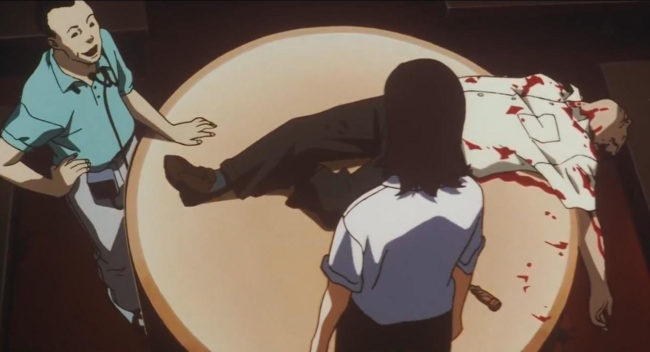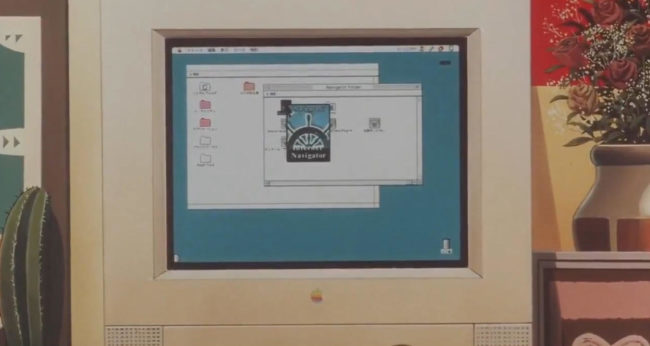Hidden Anime Gems: Perfect Blue
Posted on March 9, 2017 by Stephen Smith in Anime Reviews // 0 Comments
It’s not often Hollywood admits to ripping off anime, unless forced to in court, so it’s no surprise this Hidden Gem still hasn’t quite gotten the love it deserves. Loosely based on a novel by Yoshikazu Takeuchi, Perfect Blue was actually slated to be a live direct-to-video movie before an earthquake slashed its budget, leading to it becoming an anime instead. Blue became a critical darling on the festival circuit, scooping up a handful of awards and catching the attention of Manga Entertainment, the ruler of the American anime scene in the 90’s. Unlike most titles, Perfect Blue got its own spotlight in a separate, creepy trailer that immediately sent my teenage self on a mission. Of course, I wasn’t disappointed.
Mima Kirigoe, the lead singer of the middling pop group, Cham!, decides to leave her band mates behind and make the jump into acting, not just for her but also for her managing group, Rumi and Tadokoro. The music industry isn’t bringing in any real money and everyone has to eat. After nabbing a guest spot on Double Bind, a procedural eerily close to Law & Order: SVU, the pressures and scrutiny begin to weigh on Mima as she struggles to break from her pop idol image. On her way to going full Elizabeth Berkley (Miley Cyrus for the younger crowd) the stresses of her career, the stalkers it brings, and her inability to say “no” blur the lines between reality and fantasy in a psychological thriller wrapped in a drama about the seedy side of show business.
The hallmark, or the weakness to some, of Perfect Blue is the forced perspective of Mima. We’re forced to roll down her road of insanity, arm-in-arm into a foggy narrative that few are fully able to follow the first time around. Blue is one of those movies you have to watch twice to fully grasp thanks to Mima’s slow unraveling through the beating she takes. While the technology can be dated at times, the game doesn’t change when it comes to fame and show biz. In a bid to extend her role and mature her image, Tadokoro’s insistence to the show that Mima was willing to do anything leads to a more racy role, including a rape scene that her fans hate. In the midst of the uproar, Mima is already reeling from a mysterious fax (yes, a fax) she received with a link to Mima’s Room, a blog written by someone who somehow knows her every move, and even more chilling, her whole thought process. Fueling the fire, this “Real Mima” claims she was forced to do the scenes, prompting Me-Mania, the quintessential simple-minded sinister stalker, to step his game up.
This being the late 90’s, the internet was just taking off and most people had no idea of cat fishing yet. Feeling overwhelmed and helpless, the scenes of her show and real life meld into one, leaving her unsure of what is truly happening.
Shame and anger over what she allows herself to do, plus the dead bodies piling up around her, are the only things she knows to be true. The 2nd act is a slow descent into the dizzying mess her life becomes while Mima’s psyche cracks, causing her pop persona to appear and split from her “dirty” acts to preserve her legacy, taunt, torment, and muddy already murky waters. The bigger the cracks, the quicker the pace until the breakthrough to the last act, where you finally get to stand on firm footing again. It’s the technique that made Black Swan famous, although Darren Aronofsky refuses to give it credit despite already having bought the American rights so he could admittedly copy a scene for Requiem For A Dream. It’s a dirty game on and off screen.
As you can imagine, if an Oscar nominated director is… “influenced” by Satoshi Kon, the directing is stellar. Both in Japanese and English, the performances are great, enhanced by the animation and music. Much of the mood is set by the soundtrack, punctuating those moments of fear and Mima’s few spurts of anger. Meanwhile, Madhouse’s character animation tends to focus more on movement than detail this time around. The plot is well served by the choice, considering the haziness Perfect Blue marches into, but the quality will shift from scene to scene depending how stationary characters are, or the importance of the shot. It’s a minor gripe, especially the way Madhouse nails each moment. In particular, they manage to pull off the absurd, comedic, and pain of the rape scene filming flawlessly. Living in Mima’s skin, this film is already tense from the start, but this is the moment she truly becomes lost and resigned to float on autopilot.
Perfect Blue didn’t warrant a sequel, but it’s success reignited plans for a live action adaptation. Sticking close to the original novel, Perfect Blue: Yume Nara Samete flopped hard, making it a rare find. Regardless of Aronofsky’s snub, Blue lives on, even being featured in clips during Madonna’s 2001 tour, as well as many top anime / animation lists. If you can handle being knocked on your ass, Perfect Blue is one of the best psychological horror movies in any medium. And as an added bonus, it serves to forever remind us of one of humanity’s greatest inventions: Netscape.
Perfect Blue
-
Plot – 9/109/10
-
Dialogue – 9.5/109.5/10
-
Action – 8/108/10
-
Animation – 9/109/10
Perfect Blue
1997 | Directed by Satoshi Kon | Written By Sadayuki Murai |Production Company: Madhouse
